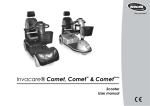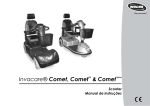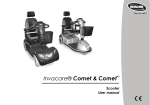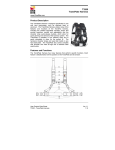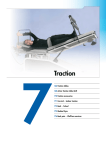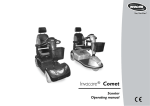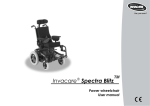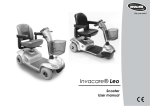Download 7 Adjustment facilities
Transcript
7 Adjustment facilities 7.1 Moving the seat position forwards or backwards The disengaging lever for adjusting the seat is located front right below the seat • Pull the lever (1) to disengage the seat. • Slide the seat forwards or backwards into the required position. • Let go the lever again to lock the seat into its required position. 39 7.2 Adjusting the armrest width The hand wheels for releasing the armrests are located under the seat (1). 40 • Turn the hand wheels to loosen the fixing for the armrest. • Adjust the armrests to the required width. • Retighten the handwheels 7.3 Adjusting the armrest height Requirements: • Phillips screwdriver • Use the screwdriver to loosen and remove the armrest fixing screw. • Adjust the armrests to the required height. • Reposition the screw and tighten again. 41 7.4 Adjusting backrest angle The lever (1) for adjusting the backrest angle is located on the right of the seat. • 42 Pull the lever and adjust the backrest to the required angle by leaning forwards or backwards. 7.5 Adjusting the lordosis supports (CometHD only) The lordosis support is the outward swell of the backrest which supports the lumbar region of the spine. You can regulate the strength of the outward swell using an air pump to fit it individually. Swelling the lordosis support more • Ensure that the air vent screw (1) is closed fully clockwise. • Pump air into the lordosis support using the rubber ball (2). The lordosis support will swell outwards more. Swelling the lordosis support less • Undo the air vent screw (1) anticlockwise and allow air to escape out of the lordosis support. The lordosis support will swell outwards less. 43 7.6 Disengaging the seat to rotate it or remove it The seat can be turned to one side to make getting in and out of the scooter easier. The seat is also easier to remove from this position. The lever for disengaging the seat is located under the seat (1) on the left. 44 • Pull the lever forwards to disengage the seat. • Turn the seat to the side. • If you want to remove the seat, hold it firmly by the backrest and front edge and remove it upwards. 7.7 Adjusting the seat height manually Requirements: • 2x open-ended spanners 17 mm • Remove the seat • Remove the battery and motor compartment cover. • Remove the seat pillar locking bolt using both openended spanners. • Adjust the seat height. • Reinsert the bolt and tighten. 45 7.8 Actuate the seat lifter (option) The rocker switch (1) for adjusting the seat lifter is located on the steering column. • 46 Press the switch up or down. The seat lifter will raise or lower. 7.9 Postural belts A postural belt is an option which can either be fixed to the wheelchair ex-works or can be retrofitted by your specialist dealer. If your wheelchair is fitted with a postural belt, your specialist dealer will have informed you about fitting and usage. The postural belt is used to help the wheelchair user keep an optimum sitting position. Correct use of the belt assists the user in sitting securely, comfortably and well-positioned in the wheelchair, especially for such users who do not have such a good sense of balance while sitting. NOTE: We recommend using the postural belt whenever the wheelchair is used. The belt should be tight enough to ensure that you are sitting comfortably and that your body is in the correct sitting position. 7.9.1 Types of postural belts Your wheelchair can be fitted with the following postural belt types ex-works. If your wheelchair has been fitted with a different belt to those listed below, please ensure that you have received the manufacturer's documentation with regard to correct fitting and use. Belt with metal buckle adjustable on one side The belt can only be adjusted on one side, which can result in the buckle not being in the middle of the waist (across pelvic area) after adjustment has taken place. 47 7.9.2 48 Adjusting the postural belt correctly • Ensure that you are sitting correctly, which means that you are sitting right at the back of the seat, your pelvis is positioned erect and as symmetrically as possible, not to the front, to the side or at one edge of the seat. • Position the postural belt so that your hipbones can be easily felt above the belt. • Adjust the belt length using one of the adjustment aids described above. The belt should be adjusted so that you can fit a flat hand between the belt and your body. • The buckle should be positioned as centrally as possible. In doing so, please carry out adjustments on both sides as much as possible. • Please check your belt every week to ensure that it is still in good working condition; to ensure it has no damage or wear, and that it is fixed properly to the wheelchair. If the belt is only fastened with a bolted connection, ensure that the connection has not loosened or undone. You can find more information about maintenance work on belts in the service manual, which is available from Invacare®. 7.9.3 Fixing the containment belt to the scooter Requirements: • jaw spanner 12 mm • jaw spanner 13 mm The fixing points (1) for attaching the belt are located under the seat (the figure shows only the left hand side). 49 50 • Take hold of the belt mounting and hold it in front of the hole in the fixing. • Position the bolt (1), screw the nut on from the other side and tighten with a jaw spanner. • Repeat the same procedure on the other side of the seat. Check to ensure that the nut is tightened properly on the bolt. 7.10 Adjusting the suspension The Comet suspension can be individually adjusted. These adjustments should only be carried out by trained specialists. Please contact your authorised Invacare specialist dealer. 7.10.1 Comet and CometAlpine Adjusting the suspension harder • Rotate the adjustable spring plate (1) clockwise when viewed from below in order to adjust the suspension harder. Adjusting the suspension softer • Rotate the adjustable spring plate (1) anticlockwise when viewed from below in order to adjust the suspension softer. 7.10.2 CometHD In the case of the CometHD, the suspension can be quickly and simply adjusted using a lever on the springs. The position of the springs (1) is marked on the vehicle with a yellow sticker. The stickers also show in which direction the lever needs to be turned to adjust the suspension harder or softer. 51














